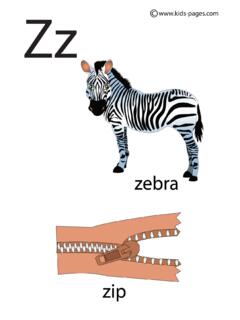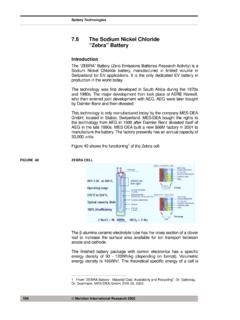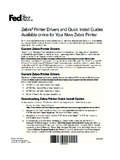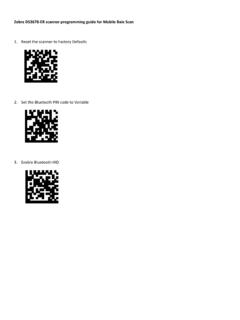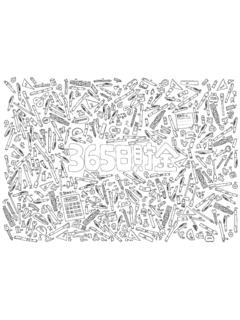Transcription of Advances in ZEBRA batteries - Gunnar Musan
1 Available online at JIIIUIII. SCIENCE @DIRECTe PDWER. SDURCIS. ELSEVIER Journal of Power Sources 127 (2004) 85-92. Advances in ZEBRA batteries MES-DEA .. VIa Laveggio /5. CH 6855 Srabio. Swirzerland Abstract ZEBRA batteries use plain salt and nickel as the raw material for their electrodes in combination with a ceramic electrolyte and a molten salt. This combination provides a battery system related specific energy of 120 Wh/kg and a specific power of 180 W /kg. With these data the battery is well designed for ali types of electric vehicles and hybrid electric buses. The ZEBRA battery technology is industrialised in Switzerland where a new plant has a capacity of 2000 packs a year with expansion prepared for 30,000 packs a year. 2003 Elsevier Ali rights reserved.
2 Keywords: ZEBRA battery; Sodium-nickel-chlonde system; High specif c energy; Beta-alumina ceramic electrolyte; Electric vehicle; Hybrid electnc bus l. Introduction and discharge cycIe has 100% charge efficiency, no charge is lost. This is due to the ceramic electrolyte. The principle ofthe ZEBRA battery was invented in South The cathode has a porous structure of nickel (Ni) and Africa and the first patent was applied in 1978. BETA Re- salt (NaCI) which is impregnated with NaAICI4, a 50/50. search and Oevelopment Ltd in England continued the de- mixture of NaCI and AlCI). This salt liquefies at 154 C and velopment and was integrated into the joint venture of AEG in the liquid state it is conductive for sodium-ions. It has (Iater Oaimler) and Anglo American Corpo IO years later.
3 The following functions, which are essenti al for the ZEBRA . The jointly founded company AEG Anglo batteries GmbH battery technology: started the pilot line production ofZEBRA batteries in 1994. I. Sodium-ion conductivity inside the cathode After the merger of Oaimler and Chrysler this joint venture The ZEBRA cells are produced in the discharged state. was terminated and the ZEBRA technology was acquired in The Iiquid salt NaAICI4 is vacuum-impregnated into the total by MES-OEA who industrialised il. The present pro- porous nickel-salt mixture that forms the cathode. It con- duction capacity is 2000 battery packs per year in a build- ducts the sodium-ions between the 13" -Ah03 ceramic ing designed for a capacity of 30,000 battery packs per surface and the reaction zone inside the cathode bulk dur- year.
4 Ing charge and discharge and makes ali cathode material available for energy storage. It also provides a homoge- nous current distribution in the ceramic electrolyte. 2, ZEBRA technology 2. Low resistive celi failure mode Ceramic is a brittle material and may have a small ZEBRA batteries use nickel powder and plain salt for crack or may break. In this case the liquid salt NaAICI4. the electrode material, the electrolyte and separator is gets into contact with the liquid sodium (the melting point 13" -AI203-ceramic which is conductive for N ions but an of sodium is 90 C) and reacts to salt and aluminium: insulator for electrons [l]. This sodium-ion conductivity has a reasonable value of NaAICI4 + 3Na -+ 4 NaCI + AI. Q-I cm,-I at 260 C and is temperature-dependent In case of small cracks in the 13"-alumina the salt and with a positive gradient [2].
5 For this reason the oper!ltional aluminium cIoses the crack. In case of a large crack or temperature of ZE~RA batteries have been chosen for the break the aluminium formed by the above reaction shorts range of 270--350 C. Fig. I shows the celi and its basic the current path between plus and minus so that the celi reaction. There is no side reaction and therefore the charge goes to low resistance. By this means long chains of 100. or 200 cells only lose the voltage of one celi ( V). but can continue to be operated. The ZEBRA battery is E-mai! ( Dustmann). celi failure tolerant. It has been established that 5-10%. 0378-7753/$ - see fronl matter 2003 Elsevier Ali nghts reserved. 86 Dllstmann/Journal oJ Power Sources /27 (2004) 85-92.
6 2 NaCI + Ni_NiCI2 + 2Na II Na AI CI4. Liquid electrolyte 13"- AI2 03. Ceramic electrolyte Capillary gap OCV Operating range at 300 C, l~o lUI- Ilr the right TCB details 5 ,on Current collector ; ;g;, O~ ~. R. ;. i Wick Charge . Il (+ poi e). Nickelchloride + 2 NaCI + Ni +-- NiCI2 + 2Na 'I~~.. Sodiumaluminiumchloride Ceramic electrolyte I I. Na AICI4. Liquid electrolyte 13"- AI2 03. Typical capacity 32Ah Sodium Ceramic electrolyte Capillary gap Celi can Wick 100% Ah-efficiency (- pole). Discharge charge .. 2 NaCI + Ni .. discharge NiCI2 + 2 Na Fig. I. Basic celi reactions. of celIs may fai! before the battery can no !onger be that the breaking behaviour of the vehicle is funda- used. The battery controlIer detects this and adjusts alI mentalIy unchanged.
7 Operative parameters. 4. Over discharge reaction This same reaction of the liquid salt and liquid sodium From the very first charge the celI has a surplus is relevant for the high safety standard of ZEBRA bat- of sodium in the anode compartment so that for an teries: In case of the mechanica! damage of the ceramic over-discharge tolerance sodium is available to maintain separator due to a crash of the car the two liquids are re- current flow at a lower voltage as indicated in Fig. 2. acting in the same way and the salt and aluminium passi- This reaction is equa! to the celI failure reaction but runs vates the NiCl2-cathode. The energy re!eased is reduced without a ceramic failure. by about 1/3 compared to the normal discharge reaction of sodium with nicke!
8 Ch!oride. ZEBRA cell design 3. Overcharge reaction The charge capacity of the ZEBRA celI is determined ZEBRA celIs are produced in the discharged state so that by the quantity of salt (NaCI) avai!ab!e in the cathode. In no metalIic sodium is to be handled. AlI the required sodium case a celI is fulIy charged and the charge vo!tage con- is inserted as salt. Fig. I shows the celI designo tinues to be applied to the celI for whatever reasons, the The positive pole is connected to the current colIector, !iquid salt NaAICI4 supplies a sodium re serve folIowing which is a hairpin shaped wire with an inside copper core the reversible reaction: for low resistivity and an outside Nickel plating so that alI. 2 NaAICI4 + Ni - 2Na + 2 AICb + NiClz Celi voltage [v].
9 This overcharge reaction requires a higher voltage than the normal charge as illustrated in Fig. 2. This has three Overdischarge 2Na+2 AICI_~+NiC~. Norma). Overchurge I. H2Na+NiCl:! Operation Ni+2 NaAk:4. H Ni+2 NBCI. 3,05. practical very welcome consequences: . (a) Any further charge current is stopped automaticalIy 3Na+NaAK:4 H 4 NaCl+AI. as soon as the increased open circuit voltage equalises th charger voltage. (b) If celIs are failed in paralIel strings of cel !>in a bat- tery, the remaining celIs in the string with the failed l,58. celIs can be overcharged in order to balance the volt- age of'jthe failed celIs. 100 o Statos of charge [%]. (c) For a vehicle with' a fulIy charged battery which is then required to go down hill there is an overcharge Fig.
10 2. Celi reactions at 300 cc. Theoretical specif c energy: 790 Wh/kg capacity of up to 5% for regenerative breaking so (normal operation). Dustmann/ Journa/ oJ Power SOllrces /27 (2004) 85-92 87. Fig. 3. 13" ceramic with thennaI compression bond (TCB) seal. Fig. 5. Cooling plates. material in contact with the cathode is consistent with the '--' celi chemistry. 278 V) strings. Between every second celi there is a cooling The cathode material in fonn of a granulated mixture of plate through which ambient air is circulated (Fig. 5) pro- salt with nickel powder and traces of iron and aluminium is viding a cooling power of kW. For thermal insulation filled into the beta-alumina tube (Fig. 3). and mechanical support the cells are surrounded by a dou- This tube is corrugated for resistance reduction by the ble walled vacuum insulation typically 25 mm thick.
